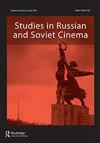Creating the Polish enemy on the Soviet screen, 1925-1939
IF 0.4
0 FILM, RADIO, TELEVISION
引用次数: 0
Abstract
ABSTRACT This article examines the presentation of Polish characters in Soviet cinema from 1925 to 1939. It argues that the many films made on the so-called ‘Polish theme’ in these years reveal a persistent Soviet anxiety towards Poland, which appears as a potential aggressor representing a military and ideological threat to the USSR in its western borderlands. Through close analysis of selected films from the corpus, the article demonstrates how Soviet cinema processed the perceived threat from Poland by means of gendered characterisations of Poles, Ukrainians and Belarusians. Most commonly, these characterisations take the form of depictions of sexual violence committed by male Poles against female Ukrainians and Belarusians, a repeated narrative feature designed to convey to Soviet audiences the danger posed by Poland to Eastern Slavs on either side of the Polish-Soviet border. Likewise, though, the films seek to alleviate spectatorial concerns by portraying a corrupted patriarchal hierarchy among Polish protagonists that represents a parodied inversion of heteronormative gender standards. By conveying the Polish danger to Soviet nationalities and simultaneously disavowing it through insinuations of Polish societal weakness, Soviet filmmakers aimed to strike a balance between communicating and assuaging spectatorial anxieties towards their western neighbour.在苏联屏幕上制造波兰敌人,1925-1939
本文考察了1925年至1939年苏联电影中波兰角色的呈现。它认为,这些年来,许多以所谓的“波兰主题”为主题的电影揭示了苏联对波兰的持久焦虑,波兰似乎是一个潜在的侵略者,代表了苏联在西部边境的军事和意识形态威胁。通过对精选电影的仔细分析,本文展示了苏联电影如何通过对波兰人、乌克兰人和白俄罗斯人的性别特征刻画来处理来自波兰的感知威胁。最常见的是,这些刻画以波兰人男性对乌克兰和白俄罗斯女性实施性暴力的描述形式出现,这是一种重复的叙事特征,旨在向苏联观众传达波兰对波兰-苏联边界两侧的东斯拉夫人构成的危险。同样,这些电影试图通过描绘波兰主角中腐朽的父权等级制度来减轻观众的担忧,这代表了对异性恋规范性别标准的模仿反转。通过向苏联民族传达波兰的危险,同时通过暗示波兰社会的弱点来否认波兰的危险,苏联电影人的目的是在沟通和缓解观众对西方邻国的焦虑之间取得平衡。
本文章由计算机程序翻译,如有差异,请以英文原文为准。
求助全文
约1分钟内获得全文
求助全文

 求助内容:
求助内容: 应助结果提醒方式:
应助结果提醒方式:


